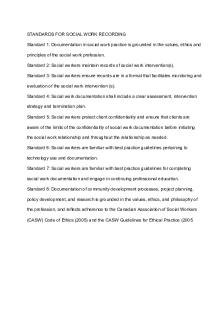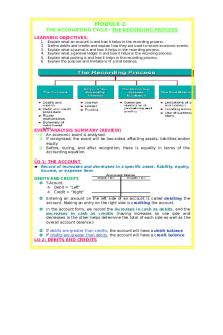Process Recording Assignment PDF

| Title | Process Recording Assignment |
|---|---|
| Author | Kayla Chapman |
| Course | Psychiatric-Mental Health Nursing for Accelerated BSN Students |
| Institution | California State University San Marcos |
| Pages | 7 |
| File Size | 165.5 KB |
| File Type | |
| Total Downloads | 27 |
| Total Views | 147 |
Summary
Process Recording assignment for psych...
Description
1
CSUSM- SCHOOL OF NURSING NURSING 261/361 PROCESS RECORDING Student Name:
Date: 10/5/19
Patient Initials: GS
Patient Diagnosis: Depression, Bipolar disorder 1 Patient Age: 33
____________________________________________________________________________________________________________ 1. Describe where and when this interaction took place: The interaction took place in the community room around 8am. She sat down across from another patient I was currently speaking to and started talking to us.
2. Discuss any pertinent events that occurred on the unit or with this patient immediately prior to the interaction. The patient I had been talking to was discussing why she was depressed and GS sat down and started encouraging her to be happy.
3. Discuss your purpose for having this interaction. What were you hoping to achieve? I was hoping to establish report and trust with GS.
4. Describe your feelings at the initiation of the interaction I was excited that she sat down because she had a lot of energy and the patient I was talking to was very sad. GS was enthusiastic and brought a positive energy to the table.
2
CSUSM: PROCESS RECORDING
NURSE/PATIENT INTERACTION Nurse Communication: (a) Actual words, non-verbal, and Para verbal. (b) Technique used (c) Was it therapeutic or nontherapeutic (d) How was it influenced by your feelings, values, and/or biases?
Patient Communication: (a) Actual words, non-verbal, and Para verbal response of the patient
I’m getting discharged today! (I was talking to another patient and she sat down and told us) Non-therapeutic: I did not acknowledge her appropriately. Orientation phase My feelings: I could have acknowledged her more as she sat down. I continued to listen to the current patient as I did not want her to think I was uninterested. However, it was evident that GS wanted to be noticed.
Affect appeared excited and full of energy. Reflection: She was energetic and seemed to be in a great mood. She seemed to be very happy that she was getting discharged.
Yay! That’s awesome
Yayyy! Here, sit down girl!
Non-therapeutic: Responding approvingly. This implies that the only appropriate response is the one that I am praising (Henry et al., 2016).
She is friendly and is enthusiastic. She is smiling and beckoning me to sit down. She is welcoming rapport and seems comfortable around me.
Alternative Response: (a) Select an alternative technique that may have increased the therapeutic effect of Nurse Communication (b) Provide the rationale for that selection Alternative technique: offering self “Hello, I’m Kayla. I am a student nurse with Cal State San Marcos. What is your name? Rationale: This technique acknowledges the patient and shows her that I am willing to get to know her and spend time with her (Henry et al., 2016).
I was passing judgement by implying that it was a good thing that she was getting discharged. I automatically matched her energy because she made it seem like getting discharged was a good thing, but I should not have been so quick to make that
3
Orientation phase: My feelings: I was happy that she had sat down because the patient I was talking to was discussing her depression and GS lightened the mood up.
Reflection: She was not much older than me and was speaking to me like a friend she has known for a while.
assumption. Alternative technique: active listening Active listening lets the patient know you care (Henry et al., 2016). I should have let her continue to talk instead of assuming that she was happy about it.
This is the best day of my entire life. I have everything under control and I feel great.
Alternative technique: exploring “How do you feel about getting discharged?”
She very excited and wants me to know how she feels. Maybe she is not ready to leave and is overcompensating for her fear of leaving.
Rationale: Exploring allows me to actually see how she feels about being discharged instead of just assuming based on her nonverbal expressions (Henry et al., 2016).
Aww I’m so happy for you.
I am so ready to get out of here.
Alternative technique: restating
Non-therapeutic: close-ended question This statement does not encourage her to speak about herself more (Henry et al., 2016).
She is rolling her eyes as if her experience in the unit was not very good.
“The best day of your entire life? Wow! I’m happy that you feel like you have everything under control. You must be very excited!”
That’s exciting! How are you feeling? Therapeutic: open-ended question Open-ended questions help facilitate conversation and help you get to know the patient (Henry et al., 2016).
Orientation phase My feelings: I enjoyed that she was speaking to me like a friend because it made me feel comfortable and made it easy to talk to her.
Orientation phase
Rationale: Restating allows the patient to know that I have understood what she is saying (Henry et al., 2016). She made a
4
My feelings: I am wondering if she actually feels this way or if she is exaggerating.
grand statement and I should have given it the attention she was seeking from it.
I’m glad you are feeling better and so full of energy!
I always am full of energy. They say I’m bipolar but I know I’m not.
Therapeutic: Showing acceptance and recognition This shows the patient that I care about her feelings (Henry et al., 2016).
She is getting defensive now. She is smiling and talking fast. This statement leads me to believe she still needs to accept her diagnosis.
Orientation phase My feelings: I do not really know what to say at this point so I try to bring the mood back up.
Alternative technique: open-ended question “Is there anything you are excited to do after you are discharged?” Rationale: Asking open-ended questions facilitates conversation (Henry et al., 2016). I should not keep complimenting her, but rather ask more about the exciting day.
ANALYSIS OF INTERACTION 1. Describe feelings: How did your feelings impact the entire interaction? I was happy for her but was showing approval instead of hearing her attitude about being discharged first. I reacted too quickly and I may have set the tone that her response was the only appropriate response to being discharged. She was very friendly and made me feel comfortable, which made me want to talk to her the way I would talk to good friend, instead of as a professional using therapeutic communication.
5
CSUSM: PROCESS RECORDING
2. Values: How did the topic, patient behaviors or verbal communication reflect or conflict with your personal values or make you aware of any biases you might have? My bias of people who have bipolar disorder is that they are moody all of the time. I always thought that they would either be extremely happy or extremely sad and I would feel uncomfortable talking to them because they would be extreme. However, bipolar disorder is a manageable disease that manifests itself in different ways. The disease is not black and white, there are different types and severities of the disease and with treatment, it is possible to become more stable. GS was a pleasant client and did not appear manic or depressed, showing me that bipolar disorder is not the stereotype I thought it was.
3. Theoretical Perspective: Select and discuss a theory that best supports your understanding of the meaning of the interaction or may have influenced the patient's behavior and verbal responses during the interaction. I tried to utilize the Milieu therapy theory, which means developing a therapeutic nurse-patient relationship. This type of therapy creates a safe, trusting, and supportive environment which will hopefully make the client feel comfortable. It means constantly focusing on the client’s ideas, feelings, and experiences. It involves exploring the client’s needs and problems and discussing problemsolving strategies. It allows the client to realize their strengths and weaknesses and help them develop autonomy (Henry et al., 2016). I wanted to make GS feel comfortable so that she would open up to me. I tried to let her know I was genuine, empathetic and trustworthy.
4. Reflection: Discuss what you learned about your communication style, feelings, values, and/or biases that might either enhance or hinder your therapeutic impact. I realized that I need to be more professional when I am communicating with patients. I tend to become casual and turn into more of a friend but need to work on Milieu therapy. I am at a loss for words sometimes when the patients are talking about serious topics such
6
as depression and suicide. I need to work on communicating with the patients in an effective manner. My bias toward people with bipolar disorder make me take caution when talking to them. I feel like I do not want to say something to set them off in a negative way. I worry that they can flip to depression or mania with a single conversation, and that is not true. I need to get rid of my bias toward them. Having conversations with people with bipolar disorder has helped me see that my biases are not true.
Summary: Describe key take-aways from this interaction that you will consider and practice in future interactions with patients. Some key take-aways include always being respectful and non-judgmental, never feeling afraid to strike up a conversation with the patients, and work on creating a therapeutic nurse-patient relationship. It is becoming clear to me how important it is to take the time to get to know a patient instead of judging how they are going be from initial contact or from reading their chart. I initially saw GS and was nervous to approach her because I thought she had a negative expression and would not want to talk to me. After she initiated contact and I began talking to her, I learned she was very pleasant and easy to talk to. I need to be more confident when I am at the unit, or at least fake confidence until I feel it.
7
CSUSM: PROCESS RECORDING
References Henry, McMichael, Johnson, DiStasi, Wilford, & Lemon. (2016). Rn Mental Health Nursing (10th ed.). Assessment Technologies Institute, LLC....
Similar Free PDFs

Process Recording Assignment
- 6 Pages

Process Recording Assignment
- 7 Pages

Process Recording #1 copy
- 4 Pages

Field 4 - Process Recording
- 6 Pages

Process Recording Supplement
- 5 Pages

Warranties, Recording
- 4 Pages

Processing Recording Example
- 11 Pages

Standards for recording
- 2 Pages
Popular Institutions
- Tinajero National High School - Annex
- Politeknik Caltex Riau
- Yokohama City University
- SGT University
- University of Al-Qadisiyah
- Divine Word College of Vigan
- Techniek College Rotterdam
- Universidade de Santiago
- Universiti Teknologi MARA Cawangan Johor Kampus Pasir Gudang
- Poltekkes Kemenkes Yogyakarta
- Baguio City National High School
- Colegio san marcos
- preparatoria uno
- Centro de Bachillerato Tecnológico Industrial y de Servicios No. 107
- Dalian Maritime University
- Quang Trung Secondary School
- Colegio Tecnológico en Informática
- Corporación Regional de Educación Superior
- Grupo CEDVA
- Dar Al Uloom University
- Centro de Estudios Preuniversitarios de la Universidad Nacional de Ingeniería
- 上智大学
- Aakash International School, Nuna Majara
- San Felipe Neri Catholic School
- Kang Chiao International School - New Taipei City
- Misamis Occidental National High School
- Institución Educativa Escuela Normal Juan Ladrilleros
- Kolehiyo ng Pantukan
- Batanes State College
- Instituto Continental
- Sekolah Menengah Kejuruan Kesehatan Kaltara (Tarakan)
- Colegio de La Inmaculada Concepcion - Cebu







